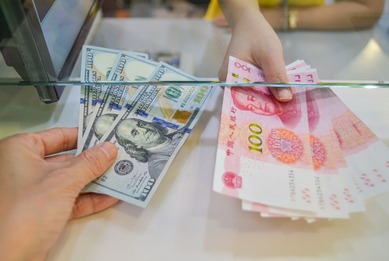 Chinese Money Laundering
Chinese money laundering organizations and individuals have emerged as a central element of a financial scheme that utilizes bulk U.S. Currency (USC) obtained from the proceeds of drug operations in the United States; subsequently, those illicit proceeds are repatriated to cartels in Mexico.
The money laundering scheme revolves around solving two issues:
(1) Desire of Mexican cartels to repatriate illicit drug proceeds into the Mexican banking system.
(2) Wealthy Chinese nationals are restricted by China's capital flight laws, which limit the transfer of money from Chinese bank accounts to use abroad.
The State Department has noted that individuals in China can only convert up to $50,000 worth of Chinese currency into U.S. dollars annually. The Chinese government has also restricted the direct transfer of Chinese currency abroad. Wealthy Chinese evade these restrictions by buying dollars from money laundering operations that exchange the USC for Chinese currency as part of the money laundering scheme. Typically, the currency remains in the country of origin in this type of exchange.

The Treasury Department's February 2022 National Money Laundering Risk Assessment noted that Chinese money laundering organizations are unique because they offer services at lower fees than traditional money brokers. Treasury detailed an example of Chinese money launderers using a six-step process to repatriate drug profits to narco-trafficking organizations.
Step 1: The Mexican cartel coordinates the delivery of bulk U.S. dollars through couriers to a Chinese money broker within the United States.
Step 2: The money broker pays the Mexican cartel in pesos in Mexico, taking a two percent commission.
Step 3: The broker transfers the U.S. dollars to a processor in the United States, who then advertises and sells the U.S. dollars to Chinese nationals in the United States.
Step 4: The Chinese nationals conduct a mobile China-to-China bank transfer in Chinese currency to bank accounts controlled by the Chinese money laundering organization.
- The Chinese money broker takes a commission of 10 percent or more.
- The Chinese nationals in the United States use U.S. dollars to purchase assets and support their lifestyle in the United States, which Chinese capital flight restrictions would otherwise limit.
- Treasury explained that the Federal Bureau of Investigation has noted the sale of cash by Chinese money laundering organizations to Chinese university students who use the cash to pay their tuition.
Step 5: The Chinese money laundering organization sells the Chinese currency to Mexican businesses or Chinese expatriates with business in Mexico to finance the purchase of Chinese goods [Similar to Trade-Based Money Laundering].
- The Chinese money broker takes another commission from the transaction.
Step 6: The Mexican businesses or Chinese expatriates with business in Mexico ship the goods to Mexico or another destination and sell them for a profit.

The State Department estimates that $154 billion in illicit funds pass through China each year. Financial Institutions will continue to be the first line of defense in combating the laundering of these illegal proceeds. Below are several examples of risk indicators for trade-based money laundering as recommended by the 2019 FATF-Egmont Report on Trade-Based Money Laundering and Indicators Paper:
- Corporate structures of trade entities are illogical and involve shell companies and companies in high-risk jurisdictions.
- A trading entity is registered or has offices in a jurisdiction with weak AML/CFT compliance.
- A trading entity displays a notable lack of typical business activities, e.g., the business lacks regular payroll transactions in line with the number of stated employees, transactions relating to operating costs, and tax remittances.
- A trade entity has unexplained periods of dormancy.
- Trade activity is inconsistent with the stated line of business of the entities involved, e.g., a car dealer is exporting clothing, or a precious metals dealer is importing seafood.
- A trading entity engages in complex trade deals involving numerous third-party intermediaries in incongruent lines of business.
- A trading company based in a high-risk jurisdiction orders electronic funds transfers for the benefit of individuals or entities in known destination countries for opioids or their precursors.
- An entity's U.S. dollar business accounts held in a known destination country exhibit flow-through activity—money is taken or transferred out of the account as quickly as it flows in.
- An entity makes large business purchases by credit card, funded by overpayments.
- An individual issues cheques, purchases drafts, or orders electronic funds transfers through the account of a legal professional for trade-related payments.
- An account of a trading entity appears to be a "pay-through" or "transit" account with a rapid movement of high-volume transactions and a small end-of-day balance without clear business reasons, including:
- An account displays frequent cash deposits transferred to persons or entities in free trade zones or offshore jurisdictions without a business relationship with the account holder.
- Incoming wire transfers to a trade-related account are split and forwarded to non-related multiple accounts with little or no connection to commercial activity.
- An entity other than the consignee makes payment for imported commodities with no apparent economic reasons, e.g., by a shell or front company not involved in the trade transaction.
|







